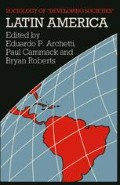Abstract
For almost a century and a half during the colonial period — 1680–1810 — the Colombian Chocó became an important source of gold in the Spanish empire. But guarded by towering mountains and dense tropical rain forests, the Chocó is an area of heat, humidity, jungle, rivers, and rainfall. Because of geography and climate the Spanish themselves rarely attempted colonization, although those who came succeeded in extracting millions of pesos’ worth of precious yellow metal. These same Spanish officials and mine owners constituted a ruling elite exhibiting little interest in anything other than accumulating wealth. Laws were violated, Indians and blacks mistreated, and bullion was produced in large quantities.
Preview
Unable to display preview. Download preview PDF.
Editor information
Copyright information
© 1987 Macmillan Publishers Limited
About this chapter
Cite this chapter
Archetti, E.P., Cammack, P., Roberts, B. (1987). Slavery. In: Archetti, E.P., Cammack, P., Roberts, B. (eds) Latin America. Sociology of “Developing Societies”. Palgrave, London. https://doi.org/10.1007/978-1-349-18629-7_3
Download citation
DOI: https://doi.org/10.1007/978-1-349-18629-7_3
Publisher Name: Palgrave, London
Print ISBN: 978-0-333-36579-3
Online ISBN: 978-1-349-18629-7
eBook Packages: Palgrave History CollectionHistory (R0)

